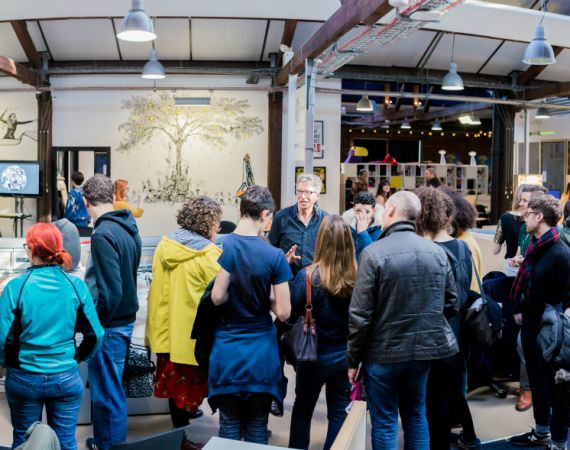Article
Posted on Thu 15 Feb 2018
CELEBRATING A DECADE OF INNOVATION AT WATERSHED’S PERVASIVE MEDIA STUDIO
Excerpt from article by Jess Connett for B247

Image by Paul Blakemore
Posted by
Excerpt from article by Jess Connett for Bristol 247, read the full article here.
Summing up the Pervasive Media Studio in a few words is a tough task, even for managing producer Verity McIntosh, who has been involved in the Studio since 2011. “It’s is a place to take risks and be brave and experiment with what you don’t know about creative uses of technology,” she says after thinking about it for a few moments.
“The Studio is quite an unusual space. It’s where you can fuse cultural and commercial ideas and experiment with creative applications of technology in a way that you perhaps don’t know the answer to when you start out.”
The Studio is a large open space, stretching up into the eaves in a corner of the Watershed many people are unaware even exists. It houses around 150 people, known as ‘residents’, all working on various projects and collaborations. App designers sit next to artists who create interactive soundscapes; a cuddly robot looks over a desk divider to a pile of electrical components, ready to be turned into personal pocket-sized spacecraft. The rule for everybody is that they must be interruptible.
The walls are covered in illustrations of some of the Studio’s most successful and well-known projects – including Playable City commissions Hello Lamp Post and Shadowing, projects that allowed you to have text message conversations with street furniture, and made street lights play back the shadows of previous passers-by – as well as some of the people who have been part of it for the past decade, depicted by artist Jasmine Thompson.
The @PMStudioUK is 10 years old - here is a throwback to smartphones in 2007, just before the studio opened. Featuring me, Paul, @timkindberg @clarered @thegingertom Incredible how much has changed in such a short time! pic.twitter.com/Hj4R6LZHGk
— Vanessa BS (@sproutness) February 15, 2018
Ten years ago, the setup was very different. In a room above Prezzo restaurant next to Bristol Aquarium on Anchor Square, the original seven residents set up a space to experiment with emerging technology, including geolocation and creating rich media experiences in public spaces. In the days before everyone had a powerful smartphone in their pocket, these creative technologists were at the forefront of design innovation.
Bringing them together was a challenge to the established notions of what technology should be, and how it should be created, Verity explains: “Watershed had been involved in lots of different discrete projects that had been looking at how creativity and technology could intersect. We were finding that there were all sorts of different things that happened when you put emerging technologies in the hands of creative people really early: they asked really great questions, they were all about user experience, and they provoked the technologists to develop in lots of different ways.
“But as soon as a project finished, or the funding expired, everyone dispersed back into their everyday lives and the momentum would be lost. So, in 2008, Watershed decided to take a bit of a gamble and create a physical place where people from technology backgrounds, from creative backgrounds, from research backgrounds, could co-locate together. By clustering people, there would be the opportunity to have serendipitous connections, and to learn and develop in more interesting ways.”

Managing producer Verity McIntosh has been part of the Studio since 2011
The initial hope was for the Studio to be “bigger than the sum of its parts”, according to original Studio director Clare Reddington, who is now Watershed’s creative director. “When we set up the Studio, we did not know exactly what we were creating apart from we wanted to make a space where people making new work would feel safe and would have a home that wasn’t reliant on project funding,” she says. “We had no idea it would become such a bustling, global hub.”
Bustling is right. On a recent Wednesday morning, people were working busily at their desks while a casual meeting took place on the sofas near the entrance. In the breakout spaces, Sharon Clarke of theatre company Raucous took a Skype call while a pair discussed ideas in the dedicated virtual reality (VR) area, headsets hanging on the wall.

A virtual reality session taking place at Watershed, created by Bristol-based VR pioneer Catherine Allen
In the event space in the back corner of the Studio, where free talks are put on every Friday lunchtime, digital technologist Becca Rose Glowacki and dancer Lisa May Thomas had laid out lengths of rope in a swirling pattern and were mapping their movements with a VR headset. On a laptop, their journeys appeared in the blackness as snaking green and blue trails. They put the headsets on again and tried to use the marks in the VR world to make sense of the physical sensations of the rope beneath their feet.
“We’re exploring the gap between seeing and feeling in VR,” Lisa explained. “I’m interested in how you can be in two realities at once, a layered reality, between what you see and what you feel.”
Lisa is working in the Pervasive Media Studio for her PhD at the University of Bristol. Based in the chemistry department, she is using VR and her background in movement to explore molecular dynamics in a completely new way. Both the University of Bristol and UWE are partners in the Studio, and many of their students are alumni – including UWE graduate Silas Adekunle of Reach Robotics, who developed the world’s first gaming robot here and is now selling it through Apple.

Playable City project Urbanimals, which appeared on Bristol’s streets in 2015. Image by Paul Blakemore
In the next space, set up as a workshop with soldering irons and saws, Lily Green of No Bindings is developing a prototype for her latest project. She creates accessible books that can be read but also listened to, with audio playing as a podcast when opened. She often works in residential home settings, using the mixture of old and new technologies to explore how Bristol can become more age-friendly. It’s just one example of the social technologies that are being developed in the Studio – an area that has hugely grown in recent years.
“What comes from this community isn’t necessary inventing new technology, but thinking about how emerging technologies connect to people’s humanity,” Verity adds. “That can be everything from social robotics to technology designed to help people in care home environments. A lot of the work happening here at the moment thinks about social challenges, the way that people live and how technology can augment and assist and make the world that we live in more joyful, rather than seeking efficiency and stripping out the messiness. Often the messiness is the interesting bit.”
Read the full article at:
www.bristol247.com/news-and-features/features/celebrating-a-decade-of-innovation-at-watersheds-pm-studio/
